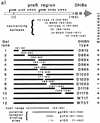Enhancement of hepatitis B virus infection by noninfectious subviral particles
- PMID: 9445049
- PMCID: PMC124627
- DOI: 10.1128/JVI.72.2.1462-1468.1998
Enhancement of hepatitis B virus infection by noninfectious subviral particles
Abstract
The biological function of the huge excess of subviral particles over virions in hepatitis B virus infections is unknown. Using the duck hepatitis B virus as a model, we unexpectedly found that subviral particles strongly enhance intracellular viral replication and gene expression. This effect is dependent on the multiplicity of infection, the ratio of virions over subviral particles, and the time point of addition of subviral particles. Most importantly, we show that the pre-S protein of the subviral particles triggers enhancement and requires the presence of the binding regions for putative cell-encoded virus receptor proteins. These data suggest that enhancement is due either to the recently described transactivation function of the pre-S protein or to signalling pathways which become activated upon binding of subviral particles to cellular receptors. The findings are of clinical importance, since they imply that infectivity of sera containing hepadnaviruses depends not only on the amount of infectious virions but also decisively on the number of particles devoid of nucleic acids. A similarly dramatic enhancing effect of noninfectious particles in other virus infections is well conceivable.
Figures





References
-
- Bolander F F., Jr Regulation of the mouse mammary tumor virus receptor by phosphorylation and internalization in mammary epithelial cells. J Cell Physiol. 1994;161:124–128. - PubMed
-
- Bouillie S, Barel M, Drane P, Cassinat B, Balbo M, Holers V M, Frade R. Epstein-Barr virus/C3d receptor (CR2, CD21) activated by its extracellular ligands regulates pp105 phosphorylation through two distinct pathways. Eur J Immunol. 1995;25:2661–2667. - PubMed
-
- Bruns M, Kratzberg T, Zeller W, Lehmann-Grube F. Mode of replication of lymphocytic choriomeningitis virus in persistently infected cultivated mouse L cells. Virology. 1990;177:615–624. - PubMed
Publication types
MeSH terms
Substances
LinkOut - more resources
Full Text Sources
Other Literature Sources
Medical

